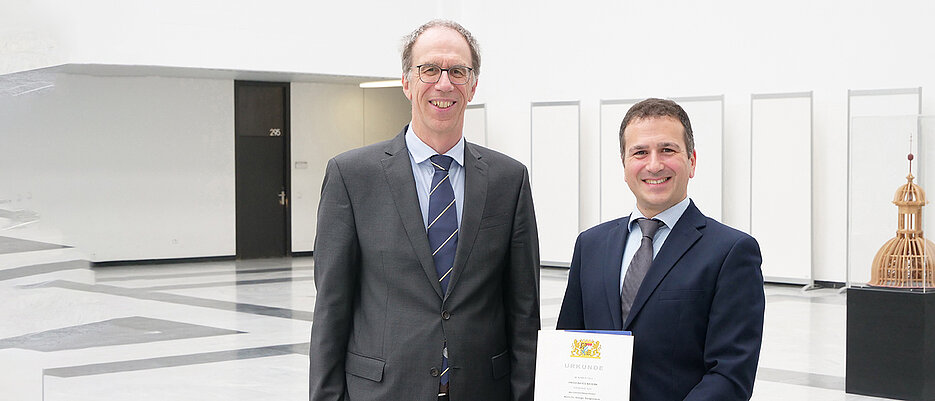New Excellence Chair: Building Bridges in the Quantum World
10/25/2023Giorgio Sangiovanni is an expert in the computer-aided calculation of quantum materials. He heads a new chair in physics that is funded by the Bavarian Ministry of Science with 1.5 million euros.

Giorgio Sangiovanni’s expertise is essential for both experimental and theoretical physicists engaged in cutting-edge collaborative research, such as at the Würzburg-Dresden Cluster of Excellence ct.qmat – Complexity and Topology in Quantum Matter.
Whenever his peers seek his assistance regarding a material, Sangiovanni begins by delving into its chemical makeup. Recognized internationally as a theory expert, he harnesses his computational toolkit to unearth the profound effects materials can exhibit due to the strong interaction between their electrons. This knowhow makes him a go-to for experimental physicists meticulously designing quantum materials atom by atom in their labs.
Theorized Concepts Meet Laboratory Validation
“More often than not, my predictions align with lab outcomes. Yet, there are times when the lab experiments unveil something totally unexpected, pushing me to hunt for its underlying rationale,” explains Sangiovanni, who has been closely associated with Julius-Maximilians-Universität (JMU) Würzburg for about a decade.
“Take, for instance, our 2021 discovery of indenene – a novel topological quantum material consisting of the element indium with a triangular lattice.” Initially, Sangiovanni proposed an idea to his experimental colleagues. However, the lab findings caught everyone off guard. Once he’d finished analyzing the unexpected phenomena, a material brimming with potential had been born: indenene – a promising contender in the production of nanoelectronic components.
Knowhow Connecting Würzburg and Dresden
“I’m a theorist through and through. I’ve been captivated by the elegance of theoretical quantum physics ever since the very first lecture I attended in Rome. Yet, every single time, I’m still eager to see whether a theoretical prediction lives up to practical testing. That’s the true litmus test,” Sangiovanni reflects. Through his expansive knowledge, he seamlessly bridges theory and practice – not to mention ct.qmat’s hubs in Würzburg and Dresden.
Key Role at ct.qmat: Harnessing Computers to Uncover Many-Body Effects
“Giorgio stands out as one of the rare scientists globally who not only bridges the divide between theoretical and experimental physicists, but also creates groundbreaking models of his own,” declared Professor Ralph Claessen, the Würzburg spokesperson for the Cluster of Excellence ct.qmat. “It’s immensely gratifying to see his pivotal contribution recognized with the new Excellence Chair.”
To develop new models, Sangiovanni explores systems that have a large number of interacting particles. To decipher patterns in the movements of electrons, he uses tools like artificial intelligence (AI). “Leveraging machine learning allows us to process vast datasets and show many-body effects efficiently. This method sidesteps the intensive energy requirements traditionally associated with supercomputers,” notes Sangiovanni. Always on the lookout for innovative topological quantum materials – such as frustrated magnets, topological superconductors, or Kagome metals – he seeks to understand their governing principles. “One day, these materials might be involved in quantum technologies used to make IT more energy efficient and powerful,” he speculates.
New Excellence Chair for the High-Tech Agenda
Giorgio Sangiovanni now has a €1.5 million grant and a dedicated chair to support his research. Since 15 October, he’s held the Chair in Computational Quantum Materials, which was recently established at JMU Würzburg in connection with the Würzburg-Dresden Cluster of Excellence ct.qmat. The Excellence Chair is funded by the Bavarian State Ministry for Science and the Arts under its High-Tech Agenda Bavaria.
Sangiovanni was born in Rome, where he first studied the French horn before discovering his love for physics. After graduating in physics, he completed a doctorate at La Sapienza University in 2005. He was a postdoc at the Max Planck Institute for Solid State Research in Stuttgart until 2008, when he moved to TU Wien (Vienna University of Technology) as a research associate. In 2012, he joined JMU Würzburg as an associate professor of theoretical physics. Giorgio Sangiovanni is one of the 25 founding members of ct.qmat.
Cluster of Excellence ct.qmat
The Cluster of Excellence ct.qmat – Complexity and Topology in Quantum Matter has been jointly run by Julius-Maximilians-Universität Würzburg and Technische Universität Dresden since 2019. Nearly 400 scientists from more than thirty countries and four continents study topological quantum materials that reveal surprising phenomena under extreme conditions such as ultra-low temperatures, high pressure, or strong magnetic fields. ct.qmat is funded through the German Excellence Strategy of the Federal and State Governments and is the only Cluster of Excellence in Germany to be based in two different federal states.






